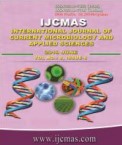


 National Academy of Agricultural Sciences (NAAS)
National Academy of Agricultural Sciences (NAAS)

|
PRINT ISSN : 2319-7692
Online ISSN : 2319-7706 Issues : 12 per year Publisher : Excellent Publishers Email : editorijcmas@gmail.com / submit@ijcmas.com Editor-in-chief: Dr.M.Prakash Index Copernicus ICV 2018: 95.39 NAAS RATING 2020: 5.38 |
A field investigation was carried out in the shade net house at the Agricultural Experimental Farm of Calcutta University at Baruipur, 24-Parganas (South) during March-June 2017 and germination tests as well as enzymatic assay were carried out in the Department of Horticulture, Institute of Agriculture Science, University of Calcutta. Out of the 19 accessions of okra under study, five genotypes were selected after screening which could sustain the salinity levels at 50 mM, 100mM and 150mM viz. Arka Anamika, Deepika, Shivani hybrid, Panchvati and Japani Jhar. A two way factorial layout was laid in CRD utilizing polybags for better realization of results and having two replicates for each of the treatment combination. The experiment comprised of 20 treatments. The germination percentage as well as the shoot length was observed to be highest in the variety Deepika under 150mM. The root length was high in Japani Jhar at 100 and 150mM. The number of primary branches per plant was high in Shivani Hybrid under 150 mM. The plant height was high in Deepika under all salinity levels while the inter-nodal length was found to be less in Panchvati under control, 50mM and 100mM. Arka Anamika also exhibited more number of leaves than rest of the genotypes at all levels of salinity. Under 50mM, and 100mM Shivani Hybrid was the earliest to flower while under 150mM it was Japani Jhar Similarly, under 50mM and 100mM Japani Jhar showed early 50% flowering followed by Panchvati and Arka Anamika. The total fresh yield per plant was highest in Japani Jhar at all the levels of salinity followed by Arka Anamika. There was a steady rise in proline and protein content among all the five genotypes with increase in stress. Catalase activity for all the cultivars was higher at 150mM strength of salt solution and it was noted highest in Arka Anamika closely followed by Panchvati. Peroxidase activity of all the five genotypes could be utilized in future breeding programme to tailor salinity tolerant okra genotypes which could effectively be utilized in marginalized lands.
 |
 |
 |
 |
 |